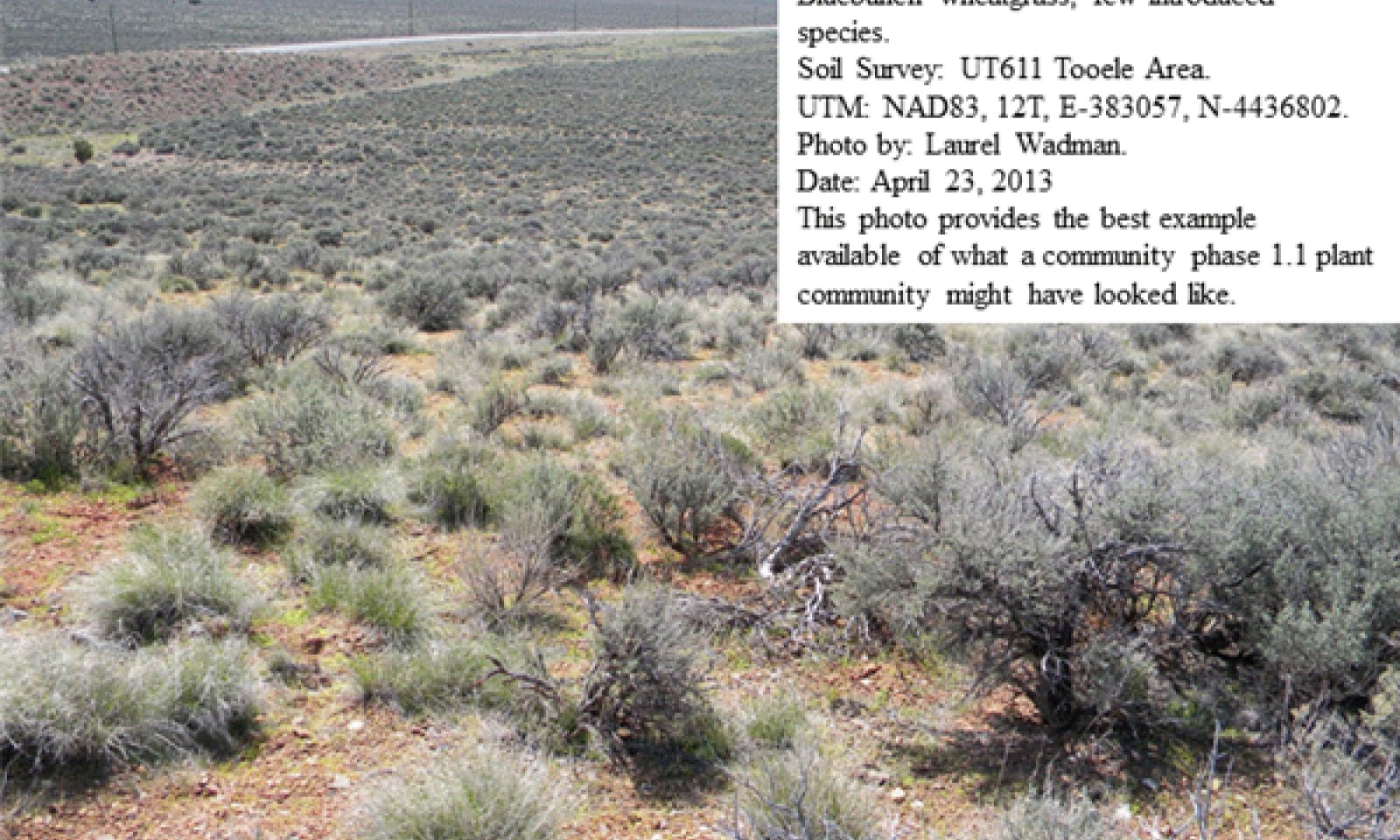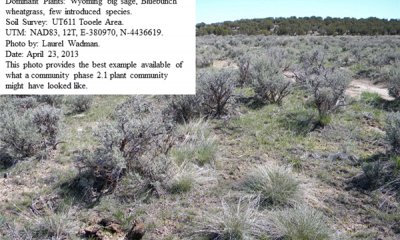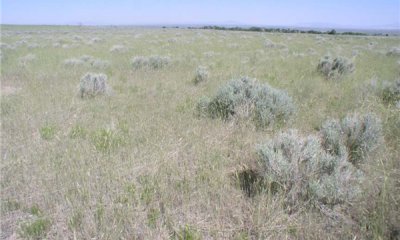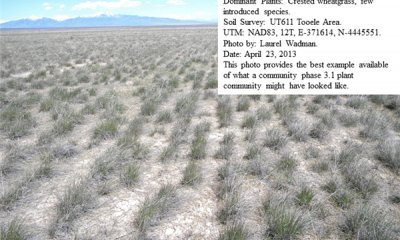
Semidesert Loam (Wyoming Big Sagebrush)
Scenario model
Current ecosystem state
Select a state
Management practices/drivers
Select a transition or restoration pathway
- Transition T1A More details
- Transition T2a More details
- Transition T2b More details
- Transition T2c More details
- Transition T3a More details
- Transition T3b More details
- Restoration pathway R3a More details
- Transition A More details
- Restoration pathway R4a More details
- Transition T5a More details
- Restoration pathway R5a More details
- Transition T6a More details
- Transition T6b More details
-
No transition or restoration pathway between the selected states has been described
Target ecosystem state
Select a state
Description
The Reference State is a representative of the natural range of variability under pristine conditions. The reference state has 3 general community phases; a shrub-grass dominant phase, a perennial grass dominant phase and a shrub dominant phase. This reference state has a well-developed shrub layer with Wyoming big sagebrush dominating. Nevada ephedra, winterfat and shadscale are other common shrub species. Bluebunch wheatgrass and Indian ricegrass are the most dominant herbaceous species with needle-and-thread, and western wheatgrass occurring. State dynamics are maintained by interactions between climatic patterns and disturbance regimes. Negative feedbacks enhance ecosystem resilience and contribute to the stability of the state. These include the presence of all structural and functional groups, low fine fuel loads, and retention of organic matter and nutrients. Plant community phase changes are primarily driven by fire, periodic drought and/or insect or disease attack.
The reference state is self-sustaining and resistant to change due to a natural resilience to its natural disturbances. The primary natural disturbance mechanisms are livestock grazing and wildlife population densities which can affect the shrub layer composition, weather fluctuations, and fire period.
Definitions:
Reference State: Natural plant communities as influenced by shrub canopy density, long term weather fluctuations, and periodic fire.
Indicators: These communities are dominated by Wyoming big sagebrush and bluebunch wheatgrass. The density of the shrub canopy determines the amount and composition of the other native species present in the community.
Feedbacks: Natural fluctuations in weather patterns that allow for a self-sustaining shrub and native grass community. Prolonged drought, an increase in fire frequency, or other disturbances may allow for the establishment of invasive species.
At-risk Community Phase: All communities are at risk when native plants are stressed and conditions are created that may allow invasive plants to establish.
Trigger: The establishment of invasive plant species.
Submodel
Description
The Current Potential State is similar to the Reference State except that non-native species are now present. This state describes the plant communities that may or have become established on this ecological site under various successional sequences and disturbance conditions. This state typically has a well developed shrub layer with Wyoming big sagebrush often dominating. Nevada ephedra and shadscale are other common shrub species. Bluebunch wheatgrass and Indian ricegrass are the dominant herbaceous species with needle-and-thread, James galleta and other perennial grasses and forbs commonly found in abundance also. These other native grasses, forbs, and shrubs may produce significant composition in the plant community. Cheatgrass, halogeton, alyssum, various mustard species and other non-native species are present on the site and under certain circumstances, may visually dominate the sites aspect.
The primary disturbance mechanisms are the shrub layer density; the amount of invasive species present; weather fluctuations; and fire. The current potential state is still self-sustaining but may be losing its resistance to change due to the impact of disturbances with less resilience following those disturbances.
Definitions:
Current Potential State: Plant communities influenced by shrub canopy density, long term weather fluctuations, and periodic fire. Invasive species are present in various amounts.
Indicators: A community dominated by Wyoming big sagebrush and bluebunch wheatgrass. The density of the shrub canopy determines the amount and composition of the other native and introduced grasses and forbs that may be present.
Feedbacks: Natural fluctuations in weather patterns that allow for a self sustaining shrub and native grass community. Prolonged drought, more frequent fires, and/or other disturbances that may allow for the increase of invasive species.
At-risk Community Phase: All communities are at risk when native plants are stressed and nutrients become available for invasive plants to increase.
Trigger: A reduction of perennial grass and forb species combined with an increase of invasive plant species.
Submodel
Description
This state is a product of many years of heavy grazing during time periods harmful to perennial bunchgrasses. Sandberg bluegrass will increase with a reduction in deep rooted perennial bunchgrass competition and become the dominant grass. Sagebrush dominates the overstory and rabbitbrush may be a significant component. Sagebrush cover exceeds site concept and may be decadent, reflecting stand maturity and lack of seedling establishment due to competition with mature plants. The shrub overstory and Sandberg bluegrass understory dominate site resources such that soil water, nutrient capture, nutrient cycling, and soil organic matter are temporally and spatially redistributed. Restoration from this site is unlikely; brush treatments have been seen to fail and instead push the site to an annual state.
Submodel
Description
This state is characterized by a dominance of Utah juniper and/or singleleaf pinyon in the overstory. Wyoming big sagebrush and perennial bunchgrasses may still be present, but they are no longer controlling site resources. Soil moisture, soil nutrients and soil organic matter distribution and cycling have been spatially and temporally altered.
Submodel
Description
This state will only occur on the upper end of the precipitation zone, adjacent to the upland ecological zone. This state is characterized by a dominance of Utah juniper and/or singleleaf pinyon in the overstory. Wyoming big sagebrush and perennial bunchgrasses may still be present, but they are no longer controlling site resources. Soil moisture, soil nutrients and soil organic matter distribution and cycling have been spatially and temporally altered.
Submodel
Description
This state is characterized by the dominance of seeded introduced wheatgrass species. Forage kochia and other desired seeded species including Wyoming sagebrush and native and non-native forbs may be present.
Submodel
Mechanism
Trigger: This transition is caused by the introduction of non-native annual weeds, such as cheatgrass, mustard, poverty weed, and halogeton.
Slow variables: Over time the annual non-native plants will increase within the community.
Threshold: Any amount of introduced non-native species causes an immediate decrease in the resilience of the site. Annual non-native species cannot be easily removed from the system and have the potential to significantly alter disturbance regimes from their historic range of variation.
Mechanism
Trigger: Inappropriate, long-term grazing of perennial bunchgrasses during growing season would favor shrubs and initiate transition to Community Phase 3.1. Fire would cause a transition to Community Phase 3.2.
Slow variables: Long term decrease in deep-rooted perennial grass density.
Threshold: Loss of deep-rooted perennial bunchgrasses changes spatial and temporal nutrient cycling and nutrient redistribution, and reduces soil organic matter.
Mechanism
Trigger: Fire or a failed seeding leads to plant community phase 4.1, inappropriate grazing management that favors shrubs in the presence of non-native annual species leads to community phase 4.2.
Slow variables: Increased production and cover of non-native annual species.
Threshold: Cheatgrass or other non-native annuals dominate understory.
Mechanism
Trigger: Time allows for trees to increase.
Slow variables: Increased establishment and cover of Utah juniper.
Threshold: Trees overtop Wyoming sagebrush and out-compete shrubs for water and sunlight. Shrub skeletons exceed live shrubs with minimal recruitment of new cohorts.
Mechanism
Trigger: Fire or abusive grazing can eliminate the Sandberg bluegrass understory and transition to community phase 4.1 or 4.2.
Slow variable: Increased seed production and cover of annual non-native species.
Threshold: Increased, continuous fine fuels modify the fire regime by changing intensity, size and spatial variability of fires. Changes in plant community composition and spatial variability of vegetation due to the loss of perennial bunchgrasses and sagebrush truncate energy capture and impact the nutrient cycling and distribution.
Mechanism
Trigger: Lack of fire allows for trees to dominate site; may be coupled with inappropriate grazing management that reduces fine fuels.
Slow variables: Increased establishment and cover of juniper trees.
Threshold: Trees overtop Wyoming sagebrush and out-compete shrubs for water and sunlight. Shrub skeletons exceed live shrubs with minimal recruitment of new cohorts.
Mechanism
Brush management with minimal soil disturbance coupled with range seeding.
Mechanism
Trigger: Catastrophic crown fire would reduce or eliminate trees to transition the site to 4.1. Tree removal when annual non-natives such as cheatgrass are present would also transition the site to state 4.0.
Slow variable: Increased seed production and cover of annual non-native species.
Threshold: Increased, continuous fine fuels modify the fire regime by changing intensity, size and spatial variability of fires. Changes in plant community composition and spatial variability of vegetation due to the loss of perennial bunchgrasses and sagebrush truncate energy capture and impact the nutrient cycling and distribution.
Mechanism
Tree removal and seeding of herbaceous species, probability of success is low.
Relevant conservation practices
| Practice | External resources |
|---|---|
|
Range Planting |
Mechanism
Trigger: Catastrophic crown fire would reduce or eliminate trees to transition the site to 4.1. Tree removal when annual non-natives such as cheatgrass are present would also transition the site to state 4.0.
Slow variable: Increased seed production and cover of annual non-native species.
Threshold: Increased, continuous fine fuels modify the fire regime by changing intensity, size and spatial variability of fires. Changes in plant community composition and spatial variability of vegetation due to the loss of perennial bunchgrasses and sagebrush truncate energy capture and impact the nutrient cycling and distribution.
Mechanism
Tree removal and seeding of herbaceous species, probability of success is low.
Mechanism
Trigger: Fire
Slow variables: Increased production and cover of non-native annual species
Threshold: Cheatgrass or other non-native annuals dominate understory
Mechanism
Trigger: Lack of fire allows for trees to dominate site; may be coupled with inappropriate grazing management that reduces fine fuels.
Slow variables: Increased establishment and cover of juniper trees
Threshold: Trees overtop Wyoming sagebrush and out-compete shrubs for water and sunlight. Shrub skeletons exceed live shrubs with minimal recruitment of new cohorts.
Model keys
Briefcase
Add ecological sites and Major Land Resource Areas to your briefcase by clicking on the briefcase (![]() ) icon wherever it occurs. Drag and drop items to reorder. Cookies are used to store briefcase items between browsing sessions. Because of this, the number of items that can be added to your briefcase is limited, and briefcase items added on one device and browser cannot be accessed from another device or browser. Users who do not wish to place cookies on their devices should not use the briefcase tool. Briefcase cookies serve no other purpose than described here and are deleted whenever browsing history is cleared.
) icon wherever it occurs. Drag and drop items to reorder. Cookies are used to store briefcase items between browsing sessions. Because of this, the number of items that can be added to your briefcase is limited, and briefcase items added on one device and browser cannot be accessed from another device or browser. Users who do not wish to place cookies on their devices should not use the briefcase tool. Briefcase cookies serve no other purpose than described here and are deleted whenever browsing history is cleared.
Ecological sites
Major Land Resource Areas
The Ecosystem Dynamics Interpretive Tool is an information system framework developed by the USDA-ARS Jornada Experimental Range, USDA Natural Resources Conservation Service, and New Mexico State University.












